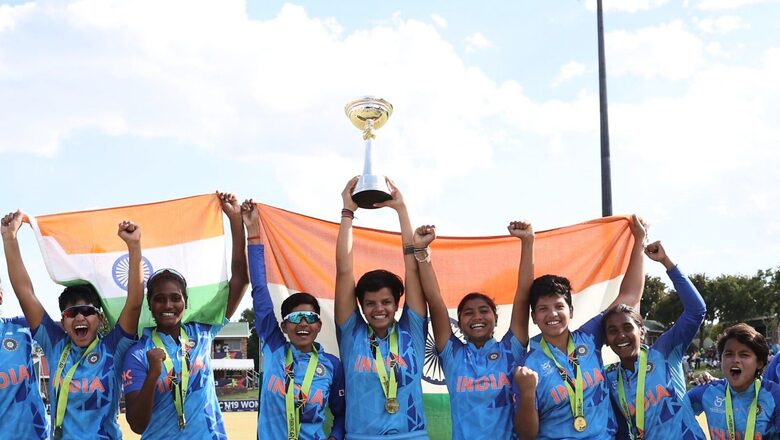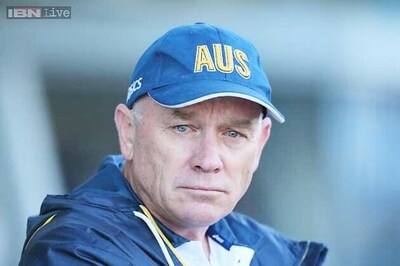
views
THE HISTORICAL DAY
Sunday, February 26, 2023. It was the day for history to be scripted for South African women’s sports as the women’s cricket team faced Australia in the final of the ICC T20 World Cup in front of a record 13,500 people at Newland ground in Cape Town.
Before this, no South African team–men or women–had played an ICC World Cup final. The action began at 1236 hours GMT, when Meg Lanning, the Australian captain won the toss and decided to bat first. Playing the seventh straight final on a trot, five-time winner, defending champions Australia have been the natural favourites. And the South African team was intended to create history.
ACTION BEGINS
Action begins with Mlaba’s first over.
Australia is 5-0. In the fifth over, Australia loses Healy c de Klerk b Kapp 18 (Australia 36-1) and South Africa tastes blood. And Newlands roar – the noise deafening, swooping, enveloping. Australia gets its mojo back at the end of the eighth over with two back-to-back boundaries by Gardner off Mlaba and it is 53/1 In the next over with two back-to-back sixes by Gardner, Australia is in cruise control mode.
It is 73/1 after 10 overs.
Soon, Australia loses its second wicket, Gardner, after a rapid-fire 29, c Luus b Tryon, Australia is 82/2. Australian batters are under pressure and the hundred arrives in the fourteenth over -103/2. Harris and skipper Lanning depart, and the momentum is back to South Africa with three overs of Australian innings left. The last over belongs to South Africa bowler Ismail who takes two wickets in two balls and the Australian innings folds at 156/6.
Beth Mooney creates history — with her 74 not out, she becomes the first batter to score two fifties in a World Cup final.
South Africa stands a chance to win. To make their dream come true.
First over. Wolvaardt opens her account with 4. SA loses the first wicket- Brits c McGrath b Brown and it is 17-1. Midway South Africa 52-2, needs an accelerometer to be in the game. They need ten and a half runs an over for the rest of the game. Instead, in a dramatic runout in the next over, captain Sune Luus sacrifices her wicket and South Africa slumps to 54/3. Hope rises when in the next two overs, Women in Green gallop from 54/3 to 98/3 and Wolvaardt cruises to 58.
After sixteen overs – 53 are needed from 24 balls.
And Wolvaardt is the hope. Next ball, she is out lbw Schutt for 61. After that, it is a formality. 43 needed from 18 balls. With two more wickets in quick succession, by the end of the 19th over, it is 130/6.
AND THE CUP GOES TO
27 runs are needed from six balls.
South Africa goes through the motion.
Gardner bowls the final over.
But the dream of Women in Green remains the dream. The match is over with South Africa 137/6. Australian women are termed champions for the third time in a row. The heroics of Laura Wolvaardt, the World Cup’s leading run scorer is in vain. Master crafter Beth Mooney is the player of the match for her 74 not out. Ash Gardner, the young Australian heartthrob, is the player of the tournament with 10 wickets and 110 runs at 36.66 in the tournament.
After the inaugural tournament in 2009, which England won, every other tournament has been won by Australia except in 2016, when it lost to West Indies in the final.
FOR INDIA, THE TIME STARTS NOW
Australia started the tournament as defending champions and favourites. It is unsurprising then; they are holding the trophy aloft for a record six times. It is what it is. But it could have been otherwise, had the semi-final gone India’s way. Chasing 172 valiantly, the Women in Blue went down fighting to Women in Yellow, the eventual winner, by five runs.
The day after a Cricket WC final is played without an Indian team in the fray, having lost in the semifinal, is traditionally marked for finger-pointing, fault-finding, witch-hunting, writing obituaries of players, sending coaches home and even sacking the whole selection panel, like what happened recently to the men’s team selectors.
Losses, however close, are losses and painful reminders of what could have been. Such times are definitely not eulogizing times or ones to celebrate the vanquished team. But I better begin with – “Well played, India, you are on the right path to being the world beaters soon.”
While congratulating Australia, I have reasons to celebrate the performance of Women in Blue. And to do full justice, to this difficult task, which is akin to ‘squaring the circle’, I will create a “balanced scorecard” of women’s cricket in India, from laboured birth to the journey so far, and will contrast their performance with that of the men’s cricket team, analysing where women’s team is today, where it is headed and what collateral support and moonshot action is needed to transport them to the top.
BUT FIRST–THE STORY OF THE OTHER MATCH
Having examined how easily mighty Australia won the final, before proceeding further, I dissect the other match, the India-Australia semifinal in which after the Indian loss, a leading Indian TV channel’s headline was- “India’s ‘Sloppy Fielding’ In Women’s T20 World Cup Semi-final Leaves Fans Infuriated.” There were more disparaging headlines elsewhere, which forces me to give my own perspective of the semifinal, which I consider amongst the finest display of Women in Blue.
Here is the canvas- venue Newland Cape Town, same as that of the final. The opponent- Defending champions, five-time World Cup winners and finalists of the past six editions. Meg Lanning and her last over carnage 6-4-6. Lanning finishes Australia’s innings with a huge six off Renuka Singh. It is massive 172/4 with Lanning unbeaten at 49* off 34 balls.
173 to chase in 20 overs is doomsday for Women in Blue in the semi-final of the 2023 ICC T20 World Cup. But the worse comes sooner.
After a terrific 10 runs in the first over, India loses Shafali Verma lbw to Megan Schutt. India 11/1. Next, Smriti Mandhana departs lbw Ashleigh Gardner. India 15/2. On the fourth ball of the fourth over, with Yastika Bhatia at four runs, is a brilliant runout of Bhatia by Grace Harris.
All is over with India 28/3 in 3.4 overs.
But Barack Obama once said – “It is not over till it is over.”
At 2030 (IST), indisposed out-of-form skipper Harmanpreet Kaur (suffering from high fever, she was in hospital for check-up hours before the match), enters the ring. Her group stage scoreline is non-flattering – ‘16, 33, 4 and 13’.
India needs a miracle. Can Harmanpreet do it? Cricketing pundits are unanimous – “no way”.
Except that with the myopic memory, pundits have forgotten the miracle crafted by Harmanpreet on July 20, 2017. Playing with a broken finger in a thunderous Harmanpreet way, she had shattered Australia in the ODI World Cup semifinal with a fiery 171 not out.
At 2031 hours of February 22, 2023, Harmanpreet returns from where she left on July 20, 2017, showing her intent and character driving Darcie Brown’s delivery through covers for four.
It was another miracle day. And it happened almost.
When on the second ball of the 11th over, Darcie Brown removed Jemimah Rodrigues, caught behind for a feisty 43, she and Harmanpreet had accumulated 69 runs for the fourth wicket and India’s scorecard was 97/4 after 10.2 overs. Victory looked in sight.
At the end of the 12th over, India needed 66 runs from 48 balls.
In the 15th over, India gallops to 132/4, when Harmanpreet smashes two back-to-back boundaries off Georgia and brings up her half-century – ‘50 runs off just 32 balls.’
India has distinct momentum in the momentous chase.
The disaster strikes at 21:20 hours (IST). In a heart-wrenching moment, Harmanpreet at 52 departs in the most bizarre run out by Ashleigh Gardner, after her bat gets stuck in the turf.
Winning formula still in India’s favour – 40 runs from 32 balls with five wickets in hand.
But the momentum shifts to Australia.
Richa Ghosh at 14 runs departs in the next over trying a big hit. But the fight goes on. Deepti Sharma hammers Gardner’s short delivery towards mid-wicket for a four. India needs 32 off 20 balls. In the 19th over, Sneh Rana departs, unable to read a ball that rattled her off stump.
It is over to wire the last over-6 balls, 16 runs needed with three wickets in hand. Deepti manages a couple each in the first two balls.
12 runs from 4 balls. Difficult yes. Impossible no.
On the third ball, Deepti takes a single. Winning equation 11 from 3. Radha Yadav, going for a big shot, perishes for duck straight into the hands of Perry at long-on!
Two balls. Eleven runs. Two wickets in hand. Two sixes on last two balls, in a high-octane match, that too against mighty Australia, was asking too much.
The story of the last two balls is familiar- Pandey manages to loft the fifth ball down the ground for a single, and Deepti dashes a final ball four. Boundary proves futile.
India out. Australia is into yet another final, seventh on the trot.
ICC T20 2023 semi-final against Australia will go down in history as one of the finest Women in Blue played, despite being on the losing side. The chase was mammoth. Australia is the team to reckon with. Women’s cricket is just coming of age in India.
This was a match in which Meg Lanning’s Australia was under pressure all along. But in the last over, where India conceded 16 runs, the bowlers were parred at course. Among batters, Jemimah showed grit and staying power. Harmanpreet Kaur was set to finish the job until she was run out in a bizarre fashion. 16 runs from the final over was difficult but doable. It is what Australia managed in their last over. Also, two early lives to Lanning’s rankled India. All India needed was two sixes and one four in the final over. It managed 10 runs, one six less.
It could have been India’s day. It was not. India’s day will come sooner. A teary-eyed Harmanpreet rightly said after the match- “The way I was batting, we had a real chance. The moment I got out, the momentum shifted from India to Australia.”
In the aftermath of the heroic loss, cricketing pundits focused on the dark glasses of Harmanpreet to hide her tears, no one remembered the tears of Rohit Sharma after 10 wickets mauling in the T20 World Cup in hands of England.
It was so near yet so far.
Stories that have begun in Indian media decrying women’s cricket need to stop. The semifinal was a match where the great game of cricket triumphed.
Before I get past analysing India’s last match, I take a leaf from Prime Minister Narendra Modi’s ‘Mann Ki Baat’ after the Indian team lost ODI 2017 World Cup final, narrowly by nine runs to England. The PM asked the nation to “choose to praise the women cricketers instead of criticizing them.”
I humbly urge the same praise to the Indian team which valiantly fought mighty Australia and lost very narrowly because India’s time starts now.
Make no mistake -there is a deep-rooted stigma globally against women playing the gentlemen’s game, more pervasive and deep-rooted in India. Women in Blue are here despite all pervasive stigmas and obstacles in their path at every level.
This piece creates a ‘balanced scorecard of Women in Blue’. Before that, I tell a story that rattled me, I call it – “Gentleman game, an ungentlemanly tale.”
GENTLEMAN GAME, UNGENTLEMANLY TALE
On the website of Lords, Mecca of cricket, the blog “Evolution of Women’s Cricket”, starts with an ungentlemanly infamous 1963 quote by England captain Len Hutton during men versus women cricket charity match- “women playing cricket was absurd, like a man trying to knit.”
Much to the chagrin of Hutton, women went on to win the match.
Lords’ website is candid. Women have played cricket for as long as men but views like Hutton’s were so common, women have been absent from official histories of the game.
Even in England, where the first recorded women’s cricket match was played in 1745, there is a long way to go before women’s cricket can be on the same footing as men’s. Women’s cricket receives much less media coverage, players are paid poorly, and tournaments are few. And still, the dominant paradigm is what W.G. Grace once said – “cricket was not a game for women.” Unsurprisingly then, in early days, England schools, universities, physical training colleges and workplaces that did play cricket usually did so in secret.
What a travesty! And what about India? I humbly posit, wait a little longer. First, a bird’s eye view of the history of women’s cricket globally followed by that in India.
A BRIEF HISTORY OF WOMEN’S CRICKET
Like men’s cricket, whose first recorded entry in a dictionary is in 1611 as a ‘boys’ game in England, women’s cricket, too, began in England with the first recorded women’s match played in 1745 in Surrey between “eleven maids of Bramley and eleven maids of Hambledon” with the teams distinguished by the colour of their hair ribbons.
Instructively, from the earliest days, women’s cricket was ridiculed, had no public acceptance and had zero financial support. It was considered more as entertainment than a sport and before 1914, it was mostly played behind closed doors.
Nonetheless, between 1890 and 1918, village women’s match got traction and 140 women’s clubs were formed in England. The watershed moment was in 1926 when the Women’s Cricket Association was established and was followed by further milestones including the first match on a first-class county ground, at Worcester in 1932.
And thus, organised, national women’s cricket competitions started in England. The status of women’s cricket as one national affair changed in 1931 with the formation of the Australian Women’s Cricket Council (AWCC). First three-match England vs Australia Women’s Test series was held in 1934-35, which England won 2-1. Thus, began international women’s cricket, initially limited to England, Australia and New Zealand.
Before I move to India’s tryst with women’s cricket, two tidbits of first England vs Australia Women’s Test series beg to be narrated-
One, England players on the 1934-35 tour had to pay for their own sea journey to Australia. It cost them £94 and 10 shillings each i.e., £4,800 in today’s money. Instead of merit, England’s team was selected through the application of who could fund her own travel cost.
This was as bad as it could go.
Two, England won two of three tests against Australia and only one against New Zealand, but the tournament was sold out. It was a crowd of 9000 in Brisbane, 9600 in Sydney and 13600 in Melbourne.
This was as good as it could go.
INDIA’S TRYST WITH WOMEN’S CRICKET
Before coming to India’s tryst with women’s cricket, a small comparative deviation with men’s cricket is in order.
Mariners of East India Company brought cricket to India in the mid-nineteenth century and sooner, the country took a fancy to it. In 1928, the Board of Control for Cricket in India (BCCI) was formed with test status to India (sixth country) and India played the first one-off test in 1932 under the captaincy of CK Nayudu at Lords, losing to England by 158 runs. It took 20 years before India won a test match against England in the 1951-52 series and a year later, in 1952, it had its first series win 2-1 against Pakistan. But India’s first series win, abroad, came in 1968 against New Zealand (2-1), against West Indies in 1971 (1-0) and England in 1971 (1-0).
I have painted the above canvas to depict that it took more than two decades for the Indian men’s cricket team to win a test match and an odd series at home and four decades for a series abroad. In the first 50 years of international cricket, Indian men had nothing much to show- 35 wins in 196 Tests.
Though this piece is about ICC Tournaments, ODI and T20 World Cups, I still wish to park the above statistics as a reference point for my analysis.
A JOURNEY BEGINS- PATNA 1976/77
Not much is known when and where women’s cricket began in India. Cricketing historian Shreyashi Talukdar in her piece ‘India Women in Test cricket: A journey begins, Patna 1976/77’ writes that in India, in the 1960s and early 1970s, women’s cricket used to be largely unstructured. Indra Nooyi, the iconic ex-CEO of PepsiCo and the only female member of the Governing Board of the International Cricket Council (ICC), recalls in her autobiography “My Life in Full- Work Family and Our Future” how in 1973, on a whim in college, she collected a team of girls and started the culture of women’s cricket in Madras. Also, in 1976, I recall girls of my own college, that included my wife’s elder sister, Rashmi, assisted by men cricketers, formed a college team of Science College and matches were played with Patna College girls.
In April 1973, the first Women’s Inter-State Nationals was held in Pune with three teams — Bombay, Maharashtra, and Uttar Pradesh. In 1973 end, the second edition was held in Varanasi, and the number of teams increased from three to eight. Women’s Cricket Association of India (WCAI) was registered under Societies Act the same year and soon, history would be created at Patna in the winter of 1976.
Unlike BCCI, which got accreditation from the ICC in 1928, the same year it was formed, WCAI received the International Women’s Cricket Council (IWCC) recognition only in 1978.
Meanwhile, International Women’s Cricket arrived in India in 1976/77 winter with the arrival of West Indies, led by Louise Patricia Brown, to play a six-test match series. The first three tests at Bangalore, Madras, and Delhi were drawn and when the rival teams descended to play the fourth test in the ancient city of Pataliputra from where the history of India for 1000 years from 6BC to 6AD was crafted, little did India know that the ‘time to script the history of women’s cricket in India had arrived.’
On November 17, 1976, when West Indies captain Brown and her Indian counterpart Rangaswamy walked out to toss at the Moin-ul-Haq Stadium, in front of a wildly roaring houseful crowd of 25,000, yours truly was in the stands not to miss a nanosecond of action.
Brown won the toss. West Indies elected to bat. And it was action time.
And what a match it was. Unlike the Indian men’s team that waited two decades for their first test victory, in the fourth test of first series, Indian women destroyed the mighty West Indies with five-wicket wins.
West Indies innings folded at 127 and 88. India scored 161/9 (declared) and 55/5. With the collapse of the Indian top order in second innings 25/5, it looked like a lost cause. But Diana Edulji and Susan Itticheria saw India home with Edulji finishing on 20 and Itticheria on 17.
Earlier, Shubhangi Kulkarni (7 wickets) and Sharmila Chakravarty (5 wickets) had proved wreckers in chief of West Indies assisted by Shantha Rangaswamy and Diana Edulji (3 wickets each). Wicketkeeper Fouzia Khalili with 58 and skipper Shantha Rangaswamy with 32 shined with the bat in the first innings that gave India a sizeable lead.
It was November 19, 1976. Indian women’s team had arrived with a bang. The men’s cricket team got the first win after two decades, whereas the women’s team tested victory in first series.
INDIAN WOMEN’S TEAM CIRCA 1976-2023- A BALANCE SCORECARD
How have Women in Blue performed so far? Here it goes-
One, for the uninitiated, compared to men’s cricket, which played first test against England in 1932 at Lords under the captaincy of CK Nayudu, women’s cricket in India arrived much later. 44 years after men’s first test, Indian women made their test debut, in 1976, against West Indies. India made its One Day International (ODI) debut at the 1978 World Cup as host and made its T20 debut in 2006 against England.
Two, Indian women have played 21 test series (total 39 tests) so far, have drawn 13 series, won four and lost four. Sadly, in the last 23 years, Indian women have had the opportunity to play only 13 tests.
Three, with regards ODI performance of the Women in Blue, out of total 301 matches played against 12 opponents, Indian women have won 164 matches, lost 132, tied one and four had no results. Despite the fact that India has lost more matches against Australia (40 out of 60), England (40 out of 76) and New Zealand (33 out of 54), India has a healthy win record of 55.38 percent.
Four, T20, starting against England in 2006, Indian women so far, out of 154 matches, have won 82, lost 68, tied 1 and had no results in 3. Again, the pattern is predictable. A healthy 54.63 win percentage despite below par percentage against Australia (19 losses out of 27 matches), England (19 losses out of 26 matches) and New Zealand (9 losses out of 13).
Five, how does the performance of the Indian women’s team compares with that of the men’s team? Lo and behold, it is a real eye-opener. In test matches, the men’s team has lost 174, won 172 and drawn 222 with win percentage of 30.34 percent. Apart from England, Australia and New Zealand, they have also lost more tests to South Africa and West Indies. In ODI, Women in Blue have edged past than Men in Blue-women’s win percentage is 55.38 percent against 55.24 percent of men. It is only in the T20 that Indian men have performed better, having won 66 percent of 199 matches again women, with a win percentage of 54 percent.
Six, in 1973, when the first Women’s ODI World Cup rolled out in England, two years before the inaugural Men’s World Cup, India was not part of seven teams. India did not have a national women’s team.
England won the first Women’s ODI World Cup defeating Australia. Between 1973 and 2023, 12 editions of the Women’s ODI World Cup have been held, but the winner club is exclusive- Australia is seven times winner, England has four trophies and the solitary other winner is New Zealand which won in 2000 as the host nation.
Australia is also the reigning champion.
Even the runners-up club of the World Cup is exclusive- England four times, New Zealand thrice, and Australia twice. Outliner finalists are West Indies, once in 2013, and India twice in 2005 and 2017. Apart from being finalists twice, Indian women have also played semifinals thrice–in 1997, 2000, and 2009.
This is quite a credible achievement of the Indian team, considering that England, Australia and New Zealand started playing way back in 1934. Women’s cricket in India not only began much later but had to fight for survival.
Seven, it is time now to examine how Women in Blue have fared in T20 World Cups.
Starting the 2009 inaugural World Cup and ending the latest 2023 edition, Women in Blue have played semi-finals on four occasions–2009, 2010, 2018 and 2023 and the final in 2020.
The women’s team were the only Asian team to play in this year’s semi final.
WOMEN IN BLUE ON ASCENDENCY
Despite Women in Blue having gone through tortuous times and rampant neglect of stakeholders including the BCCI, they are the most successful sides of Asia, winners of the latest Asia Cup, silver medalists of the Commonwealth Games and semifinalist of the latest T20 World Cup where they almost reached the finals. They also have reached to ODI World Cup final.
Three things have suddenly changed for Women in Blue, that will soon make them the team to beat-
One, it was not a long time ago when Indian women had to pay to play cricket, then came someone footing their travel, lodging and boarding bills. The rules of the game have suddenly changed. In an attempt at pay parity, towards the end of last year, the BCCI matched the match fee of international women cricketers with the same as their male counterparts. Women cricketers will be paid Rs 15 lakh, Rs 6 lakh and Rs 3 lakh. The real issue is poor pay and poorer infrastructure in domestic games, there is no pay parity even internationally. Male cricketers play far too many games. An analysis by Hindu Sport Star found that an Indian male cricketer who plays all the bilateral series in the four-year period will earn Rs 10.05 crore through match fees, while a female cricketer who plays each bilateral game till April 2025 will take home Rs 3 crore during the period.
Two, Indian girls just got the whiff of victory in the ICC World Cup. At January end, India’s U-19 team, led by Shafali Verma, lifted the trophy when they bundled out England for a paltry 68 in 17.1 overs and then crossed the Rubicon in 14 overs. It is a good omen Many stars in the Indian men’s team today have been transported from U-19.
Three, it is finally here. The first edition of the Women’s Premier League (WPL) starts in a week. Even before the first ball has been bowled, it has already made ten Indian cricketers crorepatis. The big advantage of the five-team tournament is that Indian youngsters will be thrown open in the big field, playing alongside big international stars and coached by the best in the world.
It can only get better from here.
POSTSCRIPT- MOONSHOT ACTION NEEDED
Indian women’s team was always frowned upon, even looked down upon and got stepmotherly treatment. It has just been empowered. Saurav Ganguli says that in the next three years, they will be the team to beat. I say it may be next year. What women’s cricket needs is more matches, more encouragement, more infrastructure and more resources at every level. Also, it needs attitudinal change. “Khelo Cricket” for girls U-10, U-20 and upwards and sporting scholarships.
Akhileshwar Sahay is a multi-disciplinary thought leader and India-based International Impact Consultant. He is a keen sports lover. Views expressed are personal.
Read all the Latest Opinions here




















Comments
0 comment